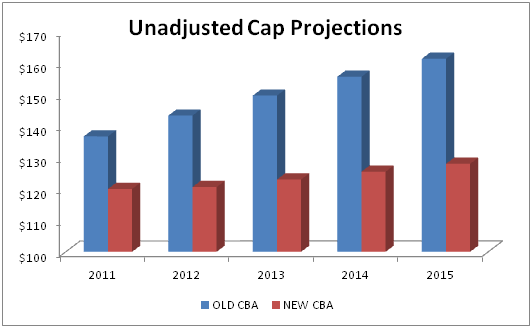[adsenseyu1]
It was only a matter of time before the things I have talked about here and on my other site regarding the new CBA began to filter through to the players.Mike Florio of Pro Football Talk pulled this soundbite from Sedrick Ellis when he appeared on Sirius XM:
And I think that’s what you’re seeing when people are saying [there’s] a little buyer’s remorse. It’s because we’re expecting a lot more money on the veteran end, and it’s just been hard. We haven’t seen as much of it as we thought we would have.
This quote was in reference to the acceptance of a rookie wage scale that was designed to put the money back into the pockets of the veteran players. There were numerous problems with that line of thinking. First and foremost was the fact that whatever projections were being made on the end of the union failed to realize just how much the new deal was going to limit the growth of the salary cap. Veteran players had grown accustomed to a cap that was skyrocketing around $6 million per year. I detailed the effects when looking at the great market correction of 2012, but here is the graph that shows the projected growth of the old CBA vs actual growth in the new CBA:
That is a load of difference in spending money for teams. Not only that but the new CBA numbers include a ton of funny money where owners are allowed to keep millions of dollars in players “performance based” earnings to help lessen the reduction of dollars going to active contracts.
To think that the rookie salary reductions would make this up is ridiculous. The overall reduction in rookie pool money on an APY basis between 2010 and 2013 is around $30 million total, less than $1 million per team. The reason its so small is because the rising minimum salaries and flat signing bonuses of the non first rounders offsets half of the gain in the first round. Even on a 1st round basis the savings are only around $1.8 million per team on a leaguewide basis. To believe that this would offset $20 million in lost cap room due to the new accounting methods is unrealistic.
The decision to remove the salary cap floor from the new CBA and replace it with a cash floor was a short term mistake. Long term we shall see, but with no penalties for failure to spend over a 4 year period other than paying money back 4 years down the line has now left a number of teams to do nothing but sit on cap space. Five teams are carrying more than $20 million in cap room and most of those teams are not spending money in cash on their players so its not an accounting trick. Its sacrificing todays players, who may have gotten paid with a cap floor, for future contracts in 2015 and 2016 where they make up the difference, saving the money for a star QB or other player to come off his low cost rookie deal. Sure there were tricks in the old CBA to use up cap room without paying money, but the NFLPA needed both cash and cap minimums per team to keep their veterans from completely falling by the wayside.
The decision to change the franchise tag formula to a smooth figure disrupted years of tag growth that protected players from being forced to accept the franchise tag by their teams. While the numbers are not perfect I wrote this article back in September of 2011 not long after the new CBA was signed that illustrated the millions the union was leaving on the floor by adopting this new formula. Here was the conclusion:
So for most positions this got the owners exactly what they wanted which is control over costs and more importantly control over the players. There is almost no possibility that the franchise tag can grow as quickly as it did under the old system which at least gave the players some leverage in negotiations. Over time we are probably going to see a scenario where more teams start using the tag on the positions that they were hesitant to in the past because of the price associated with it. Another new and interesting aspect to offseason planning in the NFL
Maybe some of it has been unrealistic for the union to project but most fans would have told you that regardless of what the salary cap is there was always going to be one or two positions that is an overpaid positions. About a decade ago it was the running back and left tackle Now its the quarterback and wide receiver. The difference is under the old system overpayment was reasonable because the cap grew. Now its salaries whose growth far outpaces the growth of the cap. Where does the difference come from? All the other positions on the team that have been de-valued.
While nobody is going to cry over players who make millions most of the players in the league dont earn that kind of money. I look at a player like Matt Slauson, a good quality guard that worked to become a starter with the Jets, who should have at least gotten a contract that gives him a little financial security for two years. Instead he had to settle for a 1 year deal that is great money for a guy like me but peanuts compared to what players like him earned 2 and 3 years ago. Not only that but now teams are going to get to hold his performance based pay for two years rather than giving it to him when he earns it so the union can artificially pump up cap space. Unfortunately his story is becoming the norm and it shouldn’t have been that way.
[adsenseyu2]
